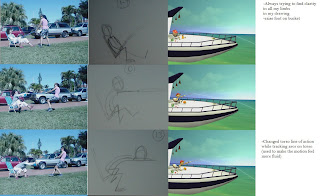"Spend half your time planning your scene and the other half animating." -Ollie Johnston
I'm going to break down my shot frame by frame so that you can see how close the final animation is to the video reference and planning. I always think you should have your entire shot in your video reference. In your drawings you refine the motions, poses and timing. In Maya you take your drawings and push the poses and timing to create your final work. Always advancing from you previous stage in your work-flow.
Fishing Shot Video Reference:
Notice how I used multiple shots to create one final shot. I had a vision in my head and I created a rough video for it. Also pay attention to how the videos cut pretty well into each other. I am always conscious of what foot is stepping forward first when I do a new camera, so that my mechanics are always matched up. Keep a close eye on those details when shooting a variety of video reference.
Drawings:
Based off of the video reference above.
Golden Poses-Tell your story in 3-4 poses.
Key Poses- Super important poses needed to sell acting physicality.
Notice the difference between Golden Poses and Key Poses.
Phrasing:
I even include a phrasing pass because a lot of the motions will be similar, so it is my job as animator to create an interesting rhythm to the shot. Very important in motions that repeat themselves, such as the pulling forward and back of a fishing rod. It's good to write down your phrases so that you can have an overall feeling of the rhythm of your shot.
Final Shot:
Pretty close to the original video reference!
Frame by frame breakdown of all the elements above:
Subtle Acting examples:
Back-story:
I created a back-story before I did any video reference so that I understood the character thoroughly. Sort of like an actor doing his research on his character, but in my case I had to create the research so I could study it.
"Mother Hurt" Animation Backstory by Kelly Perez
Thomas James was a wonderfully charming 10 year old boy. He was raised in a small upscale community, called Hartford. He had a younger brother which everyone affectionately called Timmy, and an older brother of 15 named Roger. They all live together with their mother Catherine, Grandmother Delores and his best friend in the world, his uncle Jim.
What once was a perfectly happy home for Thomas has recently been flipped upside down and turned into a battlefield with the introduction of Mr. Malnestro. This new man in their lives is intended to marry his mother and become his new father. Grandmother seems to think the world of Mr. Malnestro and his ohh so perfect upbringing. She feels they are a perfect match, and it doesn't hurt that Mr. Malnestro owns the largest estate in Hartford.
While grandmother has already begun to prepare for the wedding, Uncle Jim sees Mr. Malnestro in a completely opposite light. He has had awful fights with both mother and grandmother over his true intentions, his questionable financial practices and most importantly his devotion to mother. These are certainly frightful nights in our once peaceful home and it seems as if things have taken a turn for the worse.
Grandmother has affirmatively asked Uncle Jim to leave the house stating he is a threat to their family’s future. It certainly doesn't make any sense to Thomas and the boys, but they do remember how terribly depressed their mother became after Uncle Jim ran off Mr. Holmes a simple southern man who intended to marry their mother a few years back.
Thomas can only suppose grandmother intends for the best possible outcome with Uncle Jim out of the picture and so with a sad heart Thomas runs out to see his beloved uncle and tries to console him as best a 10 year old can. "It isn't you uncle Jim, she just, she just doesn't want so see mother hurt anymore."
Video Reference:
Planning:
Final Animation:
Two person acting shot example:
Final Animation:
Video Reference:
Notice how my rough storyboard has very rough Golden Poses that tell the entire story in 3 or 4 panels.
Drawings:
You don't have to be the greatest artist, just make sure you think of your character's emotions and you will be fine.
I hope this blog posting has helped you understand the importance of planning. It is SUPER important to think of your animation as much as possible. Think of how the setting affects your characters, think of the emotions, think of the differences in personality of your characters, think as much as humanly possible. Animation is hard work, but once you put in a lot of the thinking in the beginning it will make the end of your work-flow easier. You have to put in the work at some point, why not get an early start on it :)
Keep pushing your animation: this is hard work, but fun work!





































